
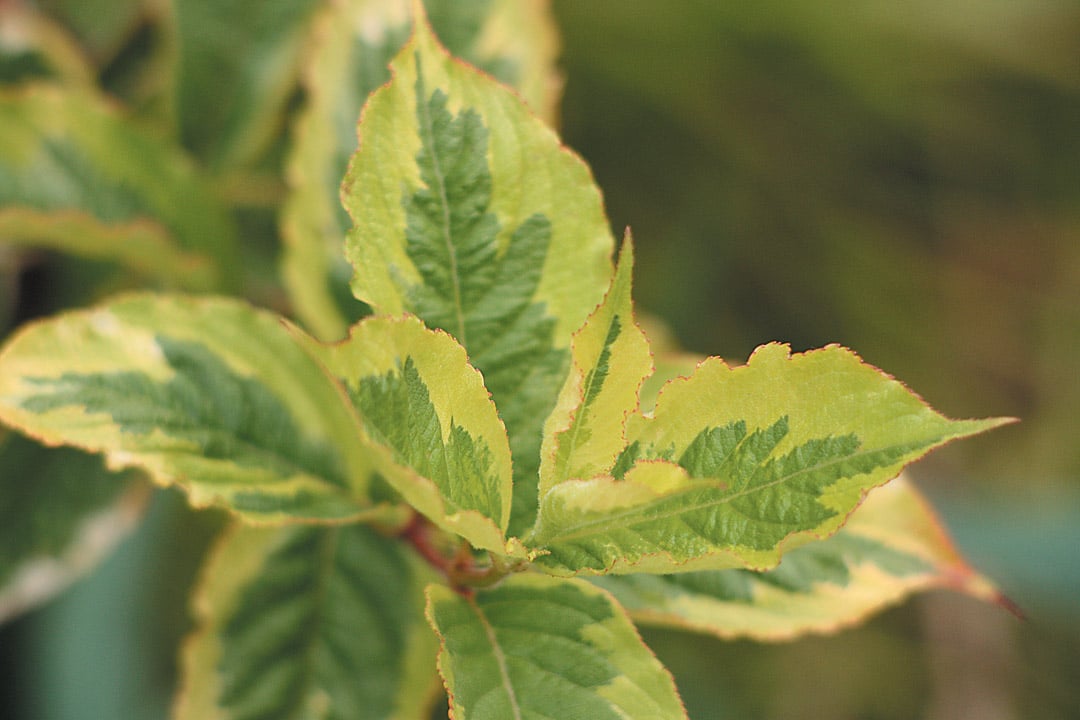
Contributor
- Topics: Archive
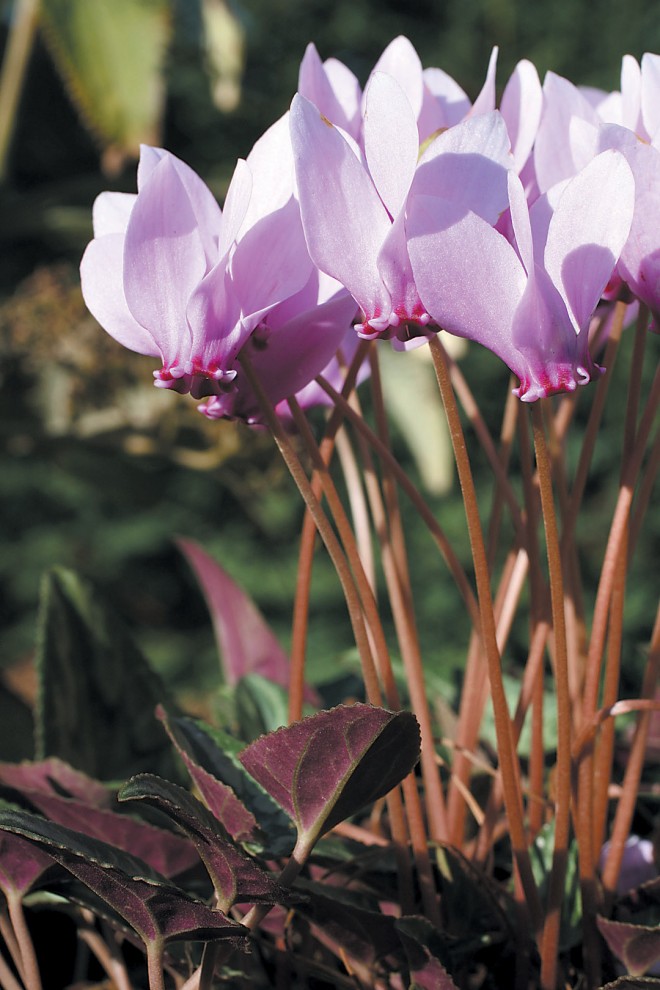
My appreciation for cyclamen begins anew each year in late summer when the first flowers appear in gardens that usually look tired, dry, and in need of something refreshing. Seemingly from nowhere, dainty, sparkling cyclamen blossoms of pink and white, dot the garden. A fresh perspective and a renewed spirit take hold and carry me well into the winter months. For many years, the Elisabeth C Miller Botanical Garden, in Seattle, has been engaged in a trial-and-error process of growing these treasured plants; we hope our observations will help others succeed with these garden gems. Some can be tricky to cultivate, being particularly sensitive to soil moisture levels during their summer dormancy. A few of these species are readily available, while others may be difficult to find. For the more uncommon species, look for seed from specialty organizations such as the Cyclamen Society or the North American Rock Garden Society.
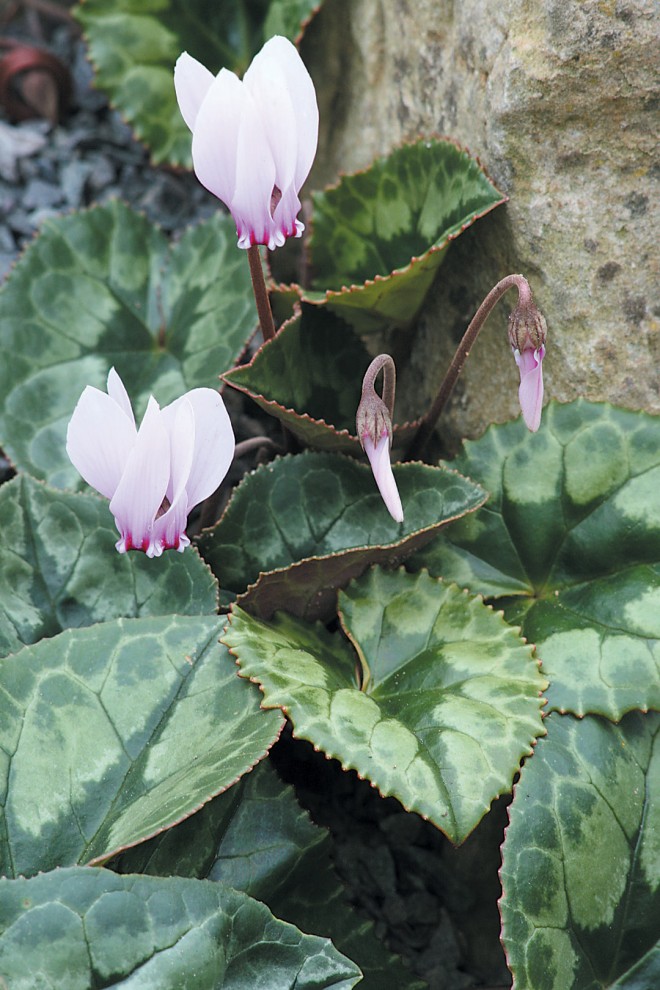
Cyclamen africanum
A tender species from North Africa, Cyclamen africanum will perish at the slightest frost [USDA zone 9]. It has been easy to grow, however, in a cool, frost-free greenhouse, the pots placed outside in late summer through early fall for us to fully enjoy the clear pink, late-season blooms. Once it has finished flowering, I return it to the greenhouse to protect the large, attractive, green-mottled leaves throughout the winter months. Many report this species being hardy in a protected location; in all likelihood, such “hardy forms” are actually C. hederifolium or hybrids of the two, as these species are almost identical. The noted bulb authority, Christopher Grey-Wilson, jokingly suggests that, to determine if you have the true species, plant it outside; if it dies over the winter, it was C. africanum. Although I would prefer to live in doubt rather than risk losing a plant, this advice does ring true. Two lovely pots of seedlings that I had raised were over-wintered in an alpine frame where the doors were accidentally left open during a cold frosty weekend. All of the seedlings quickly defoliated and the tubers turned to mush over the next month.
Cyclamen cilicium
The more subtle leaf patterns and pale pink autumn flowers of Cyclamen cilicium are less showy than those of other species, but this one has a certain charm in the garden. The narrow petals flare out with a slight twist, lending a jaunty gaiety to the flowers, which are held above round, deep green, and lightly mottled leaves. This is not the easiest species to establish; we have added it to the garden several times, only to have the tubers gradually decline and disappear. We managed to collect seed once and were rewarded with a nice crop of healthy seedlings. Fearing these, too, would succumb, I decided to add them to the garden while quite young and hope for the best. To my delight, they have performed well and each year return a little bit larger. I expect that most of the young tubers will be of flowering age this year. Mature tubers seem to transplant poorly, so starting with young plants provides the greatest chance of success. Planted in a well-drained, organic soil in bright open shade or half-day sun, this species seems to appreciate occasional summer watering, even while lying dormant below ground. [USDA zone 7; Sunset zones 3-9, 14-24]
Cyclamen cyprium
From the island of Cyprus comes this frosttender species. Our seed-grown plants have mat green leaves, colorfully splashed and spotted with gray and silver. They have been slow to reach flowering size, but, after about seven years, they have finally begun producing a few blooms. Appearing throughout the fall months, the small flowers are white with a distinctive M-shaped blotch near the base. I have always given a little water to the pots during the dormant season, but it is often suggested that the pots be allowed to dry completely. I follow my sparse water regime until the first flowers appear, then gradually increase the watering as leaves form. [USDA zone 9]
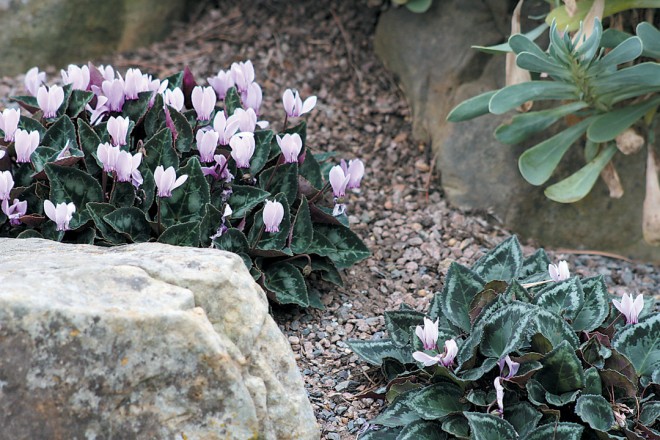
Cyclamen graecum
Entire collections have been dedicated to the infinitely varied and highly patterned heart-shaped leaves of Cyclamen graecum. The leaves range from bright green to dark black green, broken with thin and intricate silver veins punctuated by bands of mint, gray, and brilliant silver. Some forms show strikingly splashed centers of silver or pale green. An early fall-blooming species, mostly with pink or purple pink flowers, selections with white, pale pink, and deep rose flowers are also known to occur. It is always worth taking a sniff, too, as some forms are fragrant. This has not been a successful plant in our Seattle garden, being sensitive to frequent heavy frosts [USDA zone 9]. Tubers planted ten years ago are only slightly larger now than when we put them in, undoubtedly due to our cold winters. The tubers have long, thick, fleshy roots that should not be allowed to dry out completely during the summer dormancy. Our best plants are in deep, thickwalled, terra cotta pots, filled with a gritty, well-draining potting soil. This species would prefer to be planted deeply—two to six inches under the soil surface, even in containers. In areas with few heavy frosts, this would be a spectacular species to grow in the open garden.
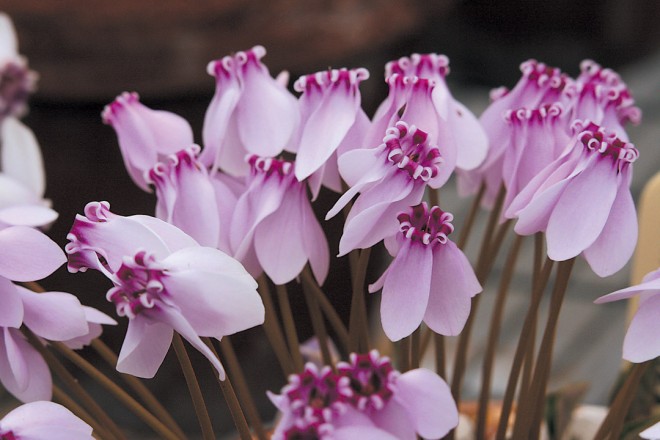
Cyclamen hederifolium
The easiest and most reliable hardy cyclamen is Cyclamen hederifolium, whose flowers range from white to deep pink and appear in abundance from late summer through fall and are followed by a spectacular assortment of patterned leaves. The leaves vary from almost entirely deep green to completely silver, with the best offering a heavy pattern of varied silvers on a forest green background. Wonderfully adaptable, this species will tolerate almost full sun in the coastal Northwest, but has more of a preference for half-day sun to deep shade in other areas; it is an excellent choice for dry shade. Provide a well-drained loamy soil, and it will reward you with many seedlings. Some gardeners actually think it reseeds too freely and thin out their old plants by pulling up monstrous tubers measuring eight inches or more across! [USDA zone 6; Sunset zones 2-9, 14-24]
There are several seed strains selected for leaf pattern and color or for unusually narrow, arrowhead-shaped leaves. By isolating particular selections and diligently removing undesirable seedlings, you can create a beautiful colony of exceptional plants. With all of the patterned and silver-leafed plants available, there is little reason to tolerate the ordinary. Although most plants on the market are a lovely purple pink or white, a careful search will reveal plants with pale pink or rich deep purple rose flowers. Selection has also given rise to fragrant forms and at least one quirky type where the floral “nose” points up, reminiscent of a shooting star (Dodecatheon, also in the same primula family). With such variation, there is still ample opportunity to make selections and develop even better seedling strains.
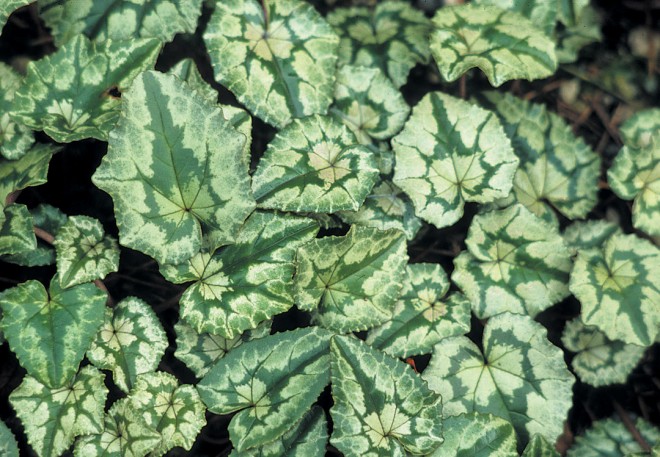
Cyclamen intaminatum
One of the smallest species, Cyclamen intaminatum is an excellent choice for containers or as a choice specimen among other jewels in a trough garden; at the Miller Garden, several plants have been carefully placed in an alpine rockery surrounded by low- and slow-growing perennials. Its diminutive stature makes this species one of the most adorable and appealing to grow. Miniature flowers of white to palest pink poke from the ground in late summer to early autumn—September, in the Seattle area. Accompanying the flowers will be a full flush of leaves, mostly green with a narrow ring of subtle silvery spots, nicely complimenting the blooms. We added these plants about four years ago into a sandy, gravelly soil in partial midday sun, where they have been slow to increase in size, but return reliably every year. [USDA zone 8]
Cyclamen mirabile
Well worth tracking down is the rare-in-gardens Cyclamen mirabile, good forms of which can have spectacular foliage. The best have leaves that emerge infused with rose pink to magenta red. The round, serrated leaves reveal rings of silver mottling with tones of pink and red as they open. The richly colored foliage emerges just after the flowers in late summer to early autumn. All of our seedlings have bright pink flowers with a magenta nose, but there are also white-flowering forms. Originally, we added these to our alpine beds, suspecting that they required excellent drainage. After a few years of languishing, we have now moved them to bright areas under high-branched conifers, hoping to mimic their native habitat of pine and oak forests. The rich organic soils in this somewhat dry location may be more to their liking, but only time will tell. [USDA zone 7]
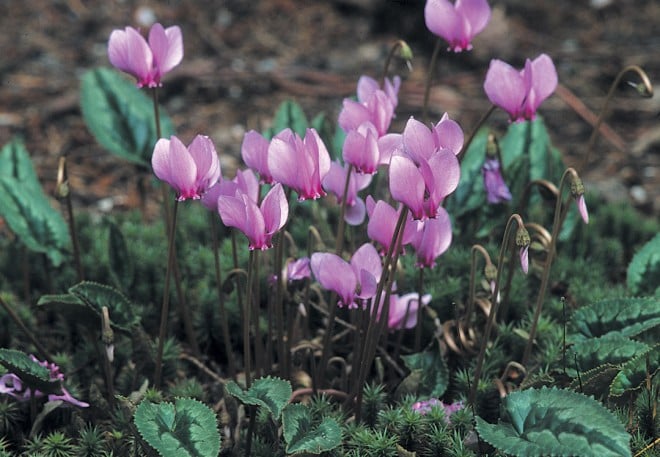
Cyclamen purpurascens
Cyclamen purpurascens produces its first flowers in late June and continues until September—the longest flowering hardy cyclamen that we grow. The rich purple pink blooms, delightfully scented with the fragrance of roses, dance just above a tuft of nearly evergreen foliage. The dark green leaves are often lightly marked with silver, and more dramatically marked selections can be found. One of the most attractive features of the leaves is their dark, burgundy red underside. This woodland species is one of the most cold-tolerant in the genus, with a wide distribution through the woodlands of Central Europe. Mysteriously, it can be a somewhat frustrating species to cultivate, often perishing in locations that seem ideal. Several old plantings at the Miller Garden have grown for well over ten years; these plantings rarely increase much nor do they produce many seedlings. Nevertheless, we have successfully collected seed and raised them in pots, later relocating the small tubers to the garden. After several years of observation and discussions with others, it appears that this species grows best in areas of rich organic soil and ample root competition (which keeps the soil from remaining too moist for too long). Our oldest tubers are buried four to six inches deep in sandy loam under the high canopy of Douglas-firs; another patch thrives at the base of an evergreen barberry. I would recommend that new tubers be planted two to three inches deep in sandy loam under mature trees where they will receive dappled light to half-day sun. Although demanding a well-drained soil, they do require regular summer watering to sustain the foliage and flowers, as they will surely perish if kept too dry through the summer months. [USDA zone 6; Sunset zones 4-9, 14-24]
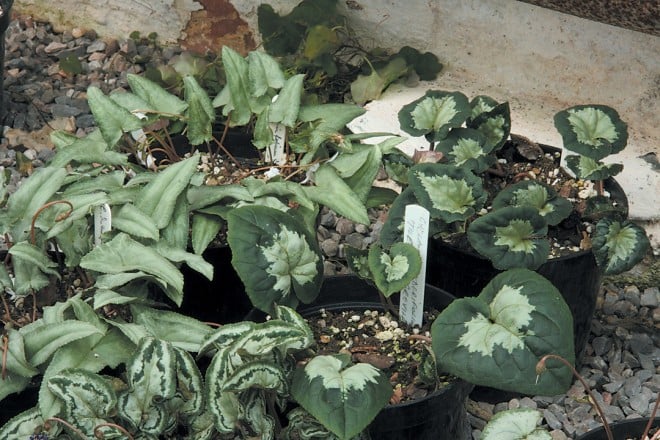
Cyclamen rohlfsianum
For those up to a challenge, Cyclamen rohlfsianum is the species to try. We have sown seed of this several times, usually resulting in healthy young plants of other species. On the few occasions when the seeds were correctly labeled, the seedlings were eventually lost, most likely from staying too damp during their long summer dormancy. Its intolerance of frost limits it to container cultivation under cover for the winter at the Miller Garden. Distinctive for its unusual, maple-shaped leaves, good forms are available with silver mottling in a broad band surrounding a deep green center. It has a reputation for enjoying a good baking during the summer and for not being tolerant of summer moisture. Flowers are typically pink, with a sweet fragrance. [USDA zone 9]
Share:
Social Media
Garden Futurist Podcast
Most Popular
Videos
Topics
Related Posts

Low Maintenance Gardens – Better for Pollinators and People
Autumn 2022 “I come out every day. It’s therapy, my meditation.” Janet’s young garden transformed from overgrown, invasive plants to mostly natives. The dailiness of

Invasive Plants Are Still Being Sold: Preventing Noxious Weeds in Your Landscape
Autumn 2022 With so many beautiful ornamental plant species and cultivars throughout California and the Pacific Northwest, how do you decide which ones to include

Garden Design in Steppe with Transforming Landscapes with Garden Futurist Emmanuel Didier
Summer 2022 Listen to full Garden Futurist: Episode XVII podcast here. Emmanuel Didier, Principal and Creative Director at Didier Design Studio is a leading figure
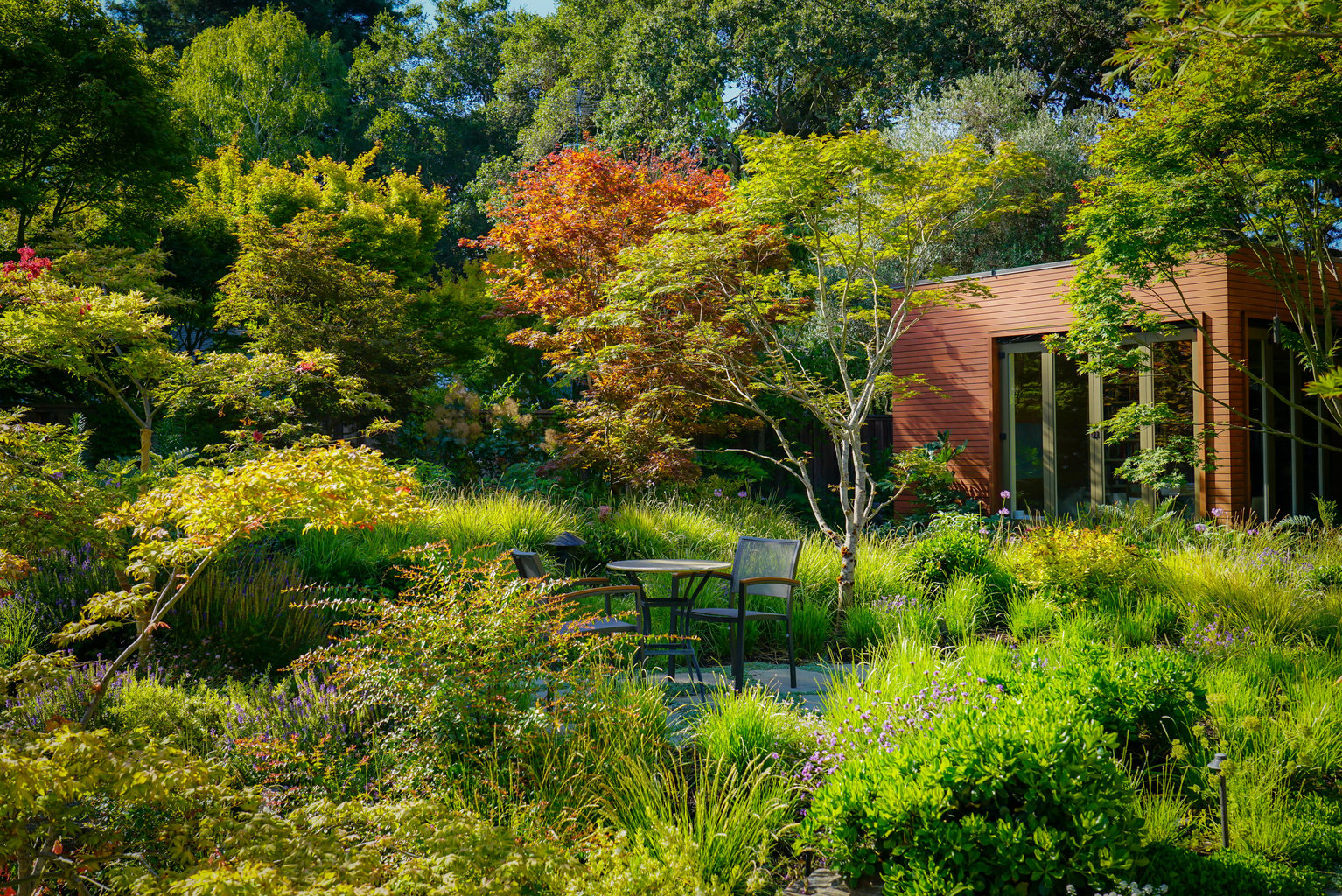
Seslerias: Versatile Groundcover Meadow Grasses
Summer 2022 Without question, the most beautiful and versatile of all the groundcover meadow grasses are the moor grasses (Sesleria). Moor grasses tick off all










Responses